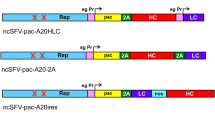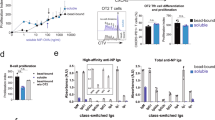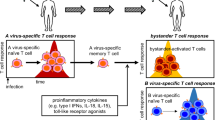Abstract
VARIOUS virus infections lead to the formation of cytotoxic lymphocytes (CL), which are capable of killing virus-infected target cells1–4. Specific lysis of target cells infected with 51Cr-labelled vaccinia virus could be observed when investigating the cell-mediated cytotoxic reaction to vaccinia virus5; the CL could be characterised as a T cell. The sensitised lymphocytes from C3H mice could only kill syngeneic L929 cells infected with vaccinia virus, whereas lysis by sensitised lymphocytes derived from DBA/2 mice was restricted to the syngeneic infected mastocytoma P815X2 cells. In the lymphocytic choriomeningitis infection the target cell lysis was shown to be restricted by H-2 antigen6. We report here experiments with primary fibroblasts of the mouse strains C3H, DBA/2 and the (C3H × DBA/2)F1 generation were designed to affirm that the effector phase of virus-specific lysis of target cells mediated by T cells is restricted by H-2 antigen even in the vaccinia virus infection. Further experiments with H-2 alloantisera were performed to indicate the close local relationship between H-2 antigens and viral surface antigens.
This is a preview of subscription content, access via your institution
Access options
Subscribe to this journal
Receive 51 print issues and online access
$199.00 per year
only $3.90 per issue
Buy this article
- Purchase on Springer Link
- Instant access to full article PDF
Prices may be subject to local taxes which are calculated during checkout
Similar content being viewed by others
References
Speel, L. F., Osborn, J. E., and Walker, D. L., J. Immun., 101, 409–417 (1968).
Marker, O., and Volkert, M., J. exp. Med., 137, 1511–1525 (1973).
McFarland, H. R., J. Immun., 113, 173–180 (1974).
Gardner, I., Bowern, N. A., and Blanden, R. V., Eur. J. Immun., 4, 68–72 (1974).
Koszinowski, U., and Thomssen, R., Eur. J. Immun, (in the press).
Zinkernagel, R. M., and Doherty, P. C., Nature, 248, 701–702 (1974).
Zinkernagel, R. M., Nature, 251, 230–231 (1974).
Shearer, G. M., Eur. J. Immun., 4, 527–533 (1974).
Zinkernagel, R. M., and Doherty, P. C., Nature, 251, 547–548 (1974).
Schlesinger, M., and Chaouat, M., Eur. J. Immun., 5, 27–32 (1975).
Hämmerling, G. J., and McDevitt, H. O., J. Immun., 112, 1634–1740 (1974).
Nabholz, M., et al., Eur. J. Immun., 4, 378–387 (1974).
Blanden, R. V., et al., Nature, 254, 269–270 (1975).
Snell, G. D., Catalogue of Mouse Alloantisera, Transplantation Immunology Branch Publication, (NIAID, NIH, Bethesda, Maryland, 1968 and 1974 supplement).
Author information
Authors and Affiliations
Rights and permissions
About this article
Cite this article
KOSZINOWSKI, U., ERTL, H. Lysis mediated by T cells and restricted by H-2 antigen of target cells infected with vaccinia virus. Nature 255, 552–554 (1975). https://doi.org/10.1038/255552a0
Received:
Accepted:
Issue Date:
DOI: https://doi.org/10.1038/255552a0
This article is cited by
-
The immune response to vaccinia virus infection in mice: analysis of the role of antibody
Archives of Virology (1989)
-
Intratumor immunologic heterogeneity
Cancer and Metastasis Reviews (1982)
-
Target-cell recognition by cloned lines of influenza virus-specific cytotoxic T lymphocytes. Selective inhibition by a monoclonal H-2-specific antibody
Immunogenetics (1982)
-
Adoptive transfer of delayed-type hypersensitivity to sendai virus
Immunogenetics (1981)
Comments
By submitting a comment you agree to abide by our Terms and Community Guidelines. If you find something abusive or that does not comply with our terms or guidelines please flag it as inappropriate.



